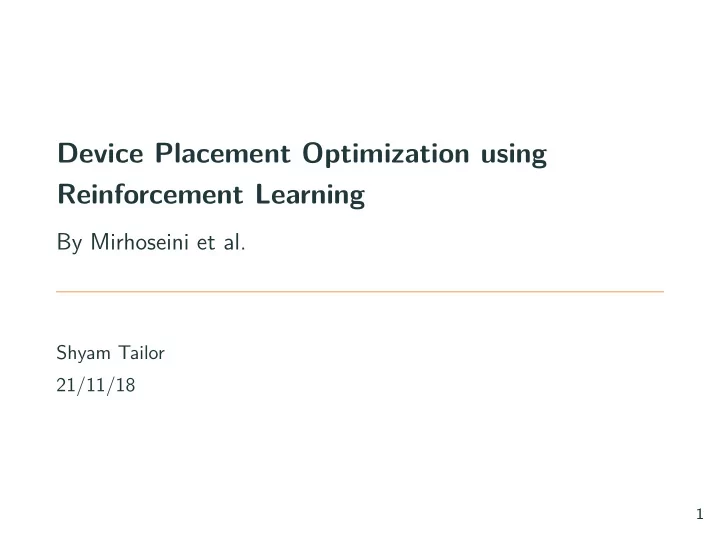

Device Placement Optimization using Reinforcement Learning By Mirhoseini et al. Shyam Tailor 21/11/18 1
The Problem machine. website. Figure from TensorFlow well. e.g. Scotch [3] do not work too • Previous automated approaches • Traditionally: use heuristics • All benchmarks run on a single • Neural Networks are getting bigger • CPUs and GPUs in the paper. environment . heterogeneous distributed • Want to schedule in a training and inference. and require greater resources for 2
This Paper’s Approach • Use Reinforcement Learning to create the placements. • Run placements in the real environment and measure their execution time as a reward signal. • Use the evaluated reward signals to improve placement policy. 3
• Details out of scope but can be done using Monte Carlo Revision: Policy Gradients Sampling. 4 • We have parameterised policies π θ , where θ is the parameter • We want to pick a policy π ∗ that maximises our reward R ( τ ) . • With policy gradients, we have an objective J ( θ ) . J ( θ ) = E τ ∼ π θ ( · ) [ R ( τ )] • Use gradient descent to optimise J ( θ ) to fjnd π ∗ .
The Reward Signal and parameter update. • Sometimes placements just don’t run — have a large constant representing a failed placement. • Square root to make training more robust. • Variance reduction : take ten runs and discard the fjrst. 5 R ( P ) = Square root of total time for forward pass, backward pass,
The Policy • Use an attentional sequence-to-sequence model which knows about devices that can be used for placements. • Input : sequence of operations in the computation graph. • Output : sequence of placements for the input operations. 6
Cutting Down the Search Space • Problem : the computation graph can be very big. • Solution : try to fuse portions of the graph as a pre-processing step where possible. • Co-locate operations when it makes sense to. • e.g. if an operation’s output only goes to one other operation, keep them together. • Can be architecture specifjc too e.g. keeping LSTM cells together or keeping convolution / pool layers together. • On evaluated networks, fused graph is around 1% the size of the original. 7
Training Setup • To avoid bottleneck, distribute parameters to controllers. • Controllers take samples, and instruct workers to run them. 8
Evaluation: Architectures and Machines • Experiments involved 3 popular network architectures: 1. Recurrent Neural Network Language Model [5, 2]. 2. Neural Machine Translation with Attention Mechanism [1]. 3. Inception-V3 [4]. • Single machine used to run experiments. • Either 2 or 4 GPUs per machine for experiment purposes. 9
Evaluation: Baselines for Comparison 1. Run entire network on the CPU. 2. Run entire network on a single GPU. 3. Use Scotch to create a placement over the CPU and GPU. • Also run experiment without allowing the CPU. 4. Expert-designed placements from the literature. 10
Evaluation: How Fast are the RL Placements? • Took between 12-27 hours to fjnd placements. 11
Evaluation: How Fast are the RL Placements? continued 12
Analysis: Why are the Placements Chosen Faster? • The RL placements generally do a better job of distributing computation load and minimising copying costs . • This is tricky — and it’s difgerent for difgerent architectures! • Inception — it’s hard to exploit model parallelism due to dependencies restricting parallelism so try to minimise copying • NMT — the opposite applies, so balance computation load. 13
Authors’ Conclusions • It looks like RL can optimise around the tradeofg between computation and copying. • The policy is learnt with nothing except the computation graph and the number of available devices. 14
Opinion: Positives • This method shows promise, as it learns simple baselines automatically, and can exceed human performance where more advanced setup is required. • At least on the networks they tested it on. • The technique was applied to difgerent architectures, and positive results were obtained for each one. • The technique should be generalisable to other system optimisation problems, in principle. 15
Opinion: Flaws in Evaluation • Policy gradients are stochastic — so why haven’t multiple runs been reported? • Is there a large variance between solutions found? • Does the algorithm sometimes fail to converge to anything useful? 16
Opinion: Improvement — Post-Processing • Is there low hanging fruit missed by the RL optimisation? • The authors never attempt to interpret the placements beyond superfjcial comments about computation and copying. 17
Opinion: Improvement — Transfer Learning • Each time the algorithm is run, it is learning about balancing copying and computation from scratch . • These concepts are not inherently unique to each network though — the precise tradeofgs may change, but the general concepts remain. 18
References Thierry Priol. Lecture Notes in Computer Science. Springer Berlin Heidelberg, https://arxiv.org/abs/1409.2329 (visited on 11/20/2018). Network Regularization”. In: (Sept. 8, 2014). url : Wojciech Zaremba, Ilya Sutskever, and Oriol Vinyals. “Recurrent Neural on 11/20/2018). Vision”. In: (Dec. 2, 2015). url : https://arxiv.org/abs/1512.00567 (visited Christian Szegedy et al. “Rethinking the Inception Architecture for Computer 2007, pp. 195–204. isbn : 978-3-540-74466-5. Parallel Processing . Ed. by Anne-Marie Kermarrec, Luc Bougé, and Dzmitry Bahdanau, Kyunghyun Cho, and Yoshua Bengio. “Neural Machine François Pellegrini. “A Parallelisable Multi-level Banded Difgusion Scheme for http://arxiv.org/abs/1602.02410 (visited on 11/20/2018). arXiv:1602.02410 [cs] (Feb. 7, 2016). arXiv: 1602.02410 . url : Rafal Jozefowicz et al. “Exploring the Limits of Language Modeling”. In: https://arxiv.org/abs/1409.0473 (visited on 11/20/2018). Translation by Jointly Learning to Align and Translate”. In: (Sept. 1, 2014). url : 19 Computing Balanced Partitions with Smooth Boundaries”. In: Euro-Par 2007
Recommend
More recommend